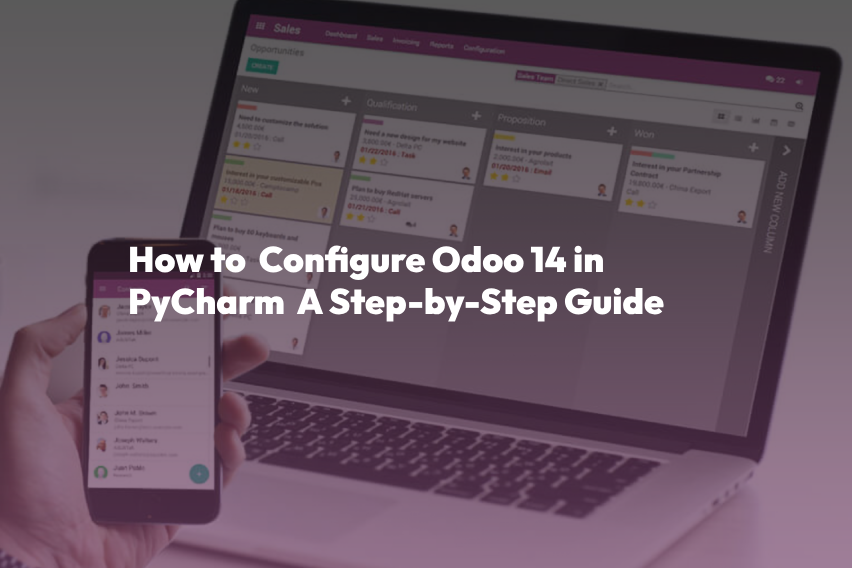How to Configure Odoo 14 in PyCharm A Step-by-Step Guide

Introduction
Odoo is a powerful and popular open-source ERP (Enterprise Resource Planning) software suite that can be customized to meet various business needs. PyCharm, on the other hand, is a widely used integrated development environment (IDE) for Python programming. Combining these two tools can be incredibly beneficial for Odoo developers. In this blog, we will walk you through the process of configuring Odoo 14 in PyCharm to streamline your development workflow.
Prerequisites
Before we dive into the configuration process, make sure you have the following prerequisites in place
Python
Odoo is primarily built using Python, so ensure you have Python 3.x installed on your system.
PyCharm
Install PyCharm on your system. You can download the community edition for free from the JetBrains website.
Git
Install Git if it’s not already on your system. Git is essential for version control and working with the Odoo source code.
Configure Odoo 14 in PyCharm
Follow these steps to configure Odoo 14 in PyCharm
Step 1: Clone the Odoo Repository
Open your terminal and navigate to the directory where you want to store the Odoo source code. Then, use Git to clone the Odoo repository:
git clone https://www.github.com/odoo/odoo --depth 1 --branch 14.0 --single-branch .This command clones the Odoo 14 repository into your current directory.
Step 2: Create a Virtual Environment
To keep your Odoo project isolated, it’s a good practice to use a virtual environment. Create one by running the following command inside your Odoo project folder
python3 -m venv venvActivate the virtual environment:
- On macOS and Linux:
source venv/bin/activate- On Windows:
venv\Scripts\activateStep 3: Install Required Dependencies
To install the necessary Python packages, use pip:
pip install -r requirements.txtThis command installs all the Python packages required by Odoo.
Step 4: Configure Odoo Server
Now, you need to configure the Odoo server. Create a configuration file named odoo.conf in your project directory:
touch odoo.confEdit this file and add the following content as a starting point:
[options]
; This is the password that allows database operations:
admin_passwd = admin
db_host = False
db_port = False
db_user = odoo
db_password = False
addons_path = /path/to/odoo/addons
logfile = /path/to/odoo/odoo.logMake sure to replace /path/to/odoo/addons and /path/to/odoo/odoo.log with the actual paths to your Odoo addons folder and log file.
Step 5: Create a PyCharm Project
Open PyCharm and create a new Python project in the directory where you cloned the Odoo repository. PyCharm will automatically detect the existing virtual environment.
Step 6: Configure the Python Interpreter
In PyCharm, go to File > Settings > Project > Python Interpreter. Select the virtual environment you created earlier.
Step 7: Create a Run Configuration
- Go to
Run > Edit Configurations. - Click the “+” button to add a new configuration and select “Python”.
- In the “Script Path” field, enter the path to the Odoo server script (
odoo-bin) in your project directory. - In the “Parameters” field, enter
-c /path/to/odoo.conf, replacing/path/to/odoo.confwith the actual path to your configuration file. - Set the working directory to your Odoo project folder.
- Click “OK” to save the configuration.
Step 8: Start Odoo Server
Now, you can start the Odoo server from PyCharm by selecting your newly created run configuration and clicking the “Run” button. You should see Odoo starting up in the PyCharm console.
Conclusion
Configuring Odoo 14 in PyCharm can greatly enhance your development experience by providing a powerful IDE for working on your Odoo projects. With this setup, you can easily manage your code, test your custom modules, and debug issues more efficiently. Remember to keep your virtual environment activated while working on your Odoo project in PyCharm, and make sure to save your work regularly. Happy coding!



